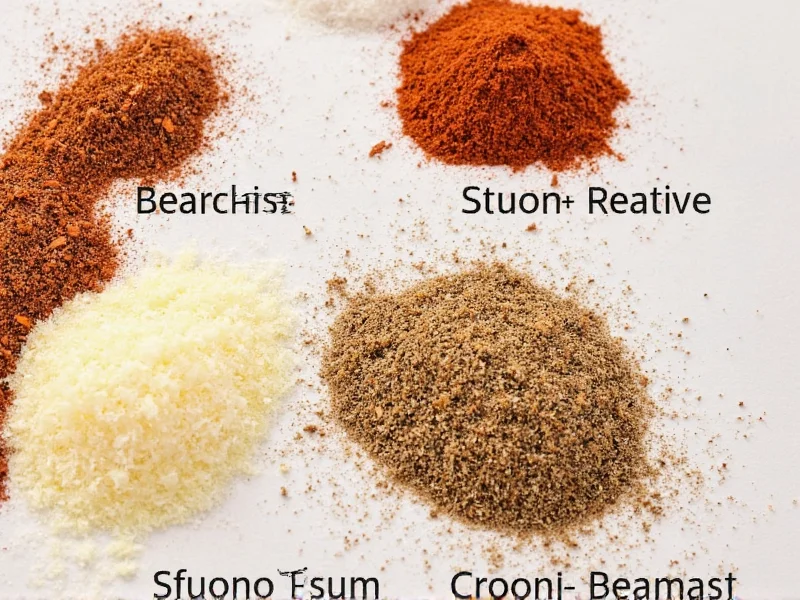Creating your own Cajun seasoning blend unlocks authentic Louisiana flavors while avoiding preservatives and excessive salt found in many commercial mixes. This versatile spice combination forms the backbone of Southern cooking, adding depth and heat to everything from blackened fish to gumbo. Unlike store-bought versions that often contain fillers, homemade Cajun seasoning lets you control the heat level and freshness of each component.
Essential Ingredients Explained
Understanding each component's role helps you adjust the blend to your taste preferences while maintaining authenticity. Traditional Cajun seasoning relies on these core elements:
| Ingredient | Flavor Contribution | Traditional Amount |
|---|---|---|
| Paprika | Earthy base, color | 2 tablespoons |
| Garlic Powder | Savory depth | 1 tablespoon |
| Onion Powder | Sweet complexity | 1 tablespoon |
| Cayenne Pepper | Heat intensity | 1 tablespoon |
| Dried Oregano | Herbal note | 1 tablespoon |
| Dried Thyme | Earthy herbal | 1 tablespoon |
| Black Pepper | Sharp warmth | 2 tablespoons |
Step-by-Step Preparation Guide
Follow these straightforward steps to create restaurant-quality Cajun seasoning at home:
- Gather all ingredients using measuring spoons for precision—this ensures consistent flavor every time you make the blend
- Combine spices in a small mixing bowl, starting with the larger quantities first to prevent clumping
- Whisk thoroughly for 60-90 seconds until the mixture achieves a uniform color and texture
- Transfer to an airtight glass container away from direct light and heat sources
- Label with preparation date and let rest for 24 hours before use to allow flavors to meld
Storage and Shelf Life Tips
Proper storage maintains your homemade Cajun seasoning's potency and prevents moisture absorption. Store in amber glass jars with tight-sealing lids in a cool, dark pantry location. Avoid plastic containers which can retain odors and potentially leach chemicals into the spices. When stored correctly, your blend remains potent for 4-6 months—significantly longer than commercial versions containing anti-caking agents.
Check freshness by rubbing a small amount between your fingers and smelling. If the aroma seems weak or musty, it's time to make a new batch. Never store spice blends near the stove or oven where heat fluctuates, as this degrades volatile oils responsible for flavor.
Culinary Applications and Usage Recommendations
This versatile blend enhances countless dishes beyond the obvious seafood applications. For chicken, use 1-2 teaspoons per pound before grilling or roasting. When seasoning ground meat for burgers or meatloaf, incorporate 1½ teaspoons per pound directly into the mixture. For vegetables, toss 1 teaspoon with 2 cups of cut vegetables before roasting.
When using in liquid-based dishes like soups or stews, add the seasoning during the last 15 minutes of cooking to preserve volatile flavor compounds. For dry rub applications, mix the Cajun seasoning with 1 tablespoon of olive oil to create a paste that adheres better to proteins. Remember that heat intensity increases when spices are heated, so reduce cayenne slightly if using in cooked applications versus raw seasoning.
Customizing Your Cajun Seasoning Blend
Personalize your homemade Cajun seasoning based on dietary needs and flavor preferences. For a milder version suitable for children, reduce cayenne to 1½ teaspoons and add ½ teaspoon celery seed for complexity without heat. Those avoiding sodium can safely omit added salt since traditional Cajun seasoning contains no salt—many commercial blends add salt as a filler.
To create a smokier profile reminiscent of grilled Louisiana cuisine, substitute 1 tablespoon of regular paprika with smoked paprika. For enhanced herbal notes characteristic of New Orleans cooking, increase thyme by ½ teaspoon and add ¼ teaspoon marjoram. Some home cooks prefer adding 1 teaspoon of ground coriander for citrusy brightness that complements shellfish dishes.
Cajun vs. Creole Seasoning: Understanding the Difference
Many home cooks confuse these Louisiana spice blends, but key distinctions exist. Traditional Cajun seasoning originates from rural Acadiana and features more peppers and less herbs, creating a hotter, earthier profile. Creole seasoning developed in New Orleans with French and Spanish influences, typically containing more herbs like parsley and sometimes tomatoes.
The critical difference lies in paprika usage—Cajun blends rely heavily on paprika for color and earthiness, while Creole blends often use less. If substituting one for the other, add ½ teaspoon dried parsley and a pinch of tomato powder to transform Cajun into Creole seasoning. Authentic Cajun cooking rarely uses tomatoes, which helps distinguish these regional variations.
Troubleshooting Common Issues
When learning how to make Cajun seasoning from scratch, several issues may arise. If your blend tastes bitter, you've likely used old spices—replace any components older than six months. For uneven heat distribution, sift the mixture through a fine mesh strainer before storage. If clumping occurs, add 1 teaspoon of uncooked rice to the container to absorb moisture.
When the flavor seems flat, check your paprika quality—Hungarian or Spanish paprika provides better depth than generic supermarket varieties. For overly salty commercial blends, remember authentic Cajun seasoning contains no salt, so adjust your recipes accordingly when substituting homemade for store-bought versions.











 浙公网安备
33010002000092号
浙公网安备
33010002000092号 浙B2-20120091-4
浙B2-20120091-4